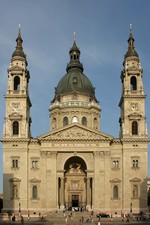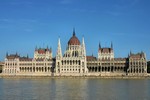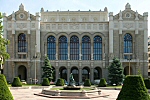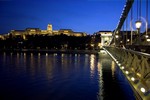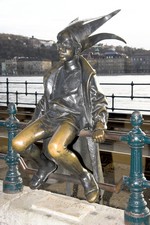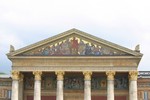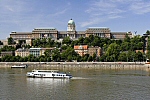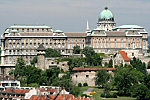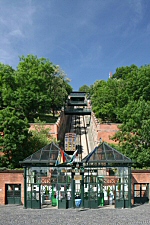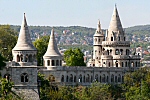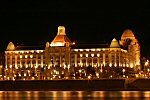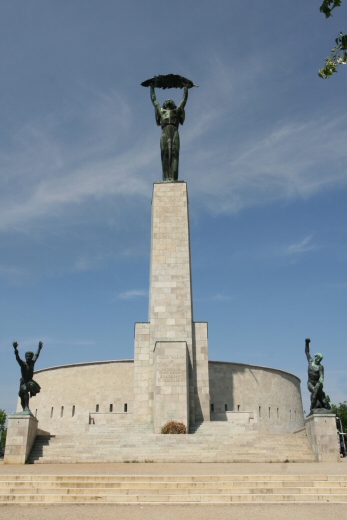Visiting Budapest
Fast-Growing Metropolis
From the middle of the nineteenth century Budapest underwent an unprecedented surge of building and expansion. In contrast with other European capital cities, whose transformation into a modern metropolis was the continuation of a long period of historical growth, Budapest attained world status and became largely what we know today over a period of only 40 to 50 years. This was not entirely due to the economic growth of the time, but also to disasters like the great floods of 1838, in which thousands of buildings in Pest were ruined. A new, modern town grew up in their place. It was at this time that the great avenues and boulevards were laid out. Some brave visionaries even considered making what became the Great Boulevard (Nagykörút) navigable, as it had once been a minor branch of the Danube. It was also in the 1840s that the first gas lamp, a great wonder of the age, appeared on the wall of the National Museum. Within a decade there were ten thousand of them being supplied by Pest’s new gasworks. This was soon followed by the first waterworks and, with the building of the Opera House, the Parliament and the bridges, by the turn of the century Budapest had caught up with its old rival Vienna.
Pioneering Air Conditioning in the Parliament
Town planners and builders of the late nineteenth century were certainly fond of grandeur and adornment – witness, for example, one of Europe’s most splendid parliament buildings on the left bank of the Danube. The Eclectic building is itself an example of the art of the period – with its Gothic towers, intricate stonework and 88 statues on the outside, and its baroque grand staircase, frescoes, mosaic windows, Gobelin tapestry and paintings inside.
The cooling system for the Parliament building was unique at the end of the 19th century. Air ventilation tunnels were routed to the two fountains that were situated in the square in front of the building, and the fresh air that was blown back into the chambers was pleasantly cooled by water. When this system was later superseded much of the tunnel work was bricked up, although some of the original air passages are still in use today. In times of great heat, circulating air can be cooled by huge quantities of ice.
On the Trail of World Heritage – by Number Two Tram
The number two tram can be boarded in Kossuth Square in front of the Parliament building: it is an excellent means of sightseeing. From its windows the entire World Heritage section of the Danube panorama of both Buda and Pest can be seen. First stop is Roosevelt Square, by the Chain Bridge, where stands the 1860’s neo-Renaissance edifice of the Hungarian Academy of Science. Next door is one of the finest art nouveau buildings, the Gresham Palace. It was the city’s largest residential structure (130,000 square feet) when it was built in 1907 for the English Gresham Life Assurance Company. After the First World War a coffee house opened on the ground floor which became a favourite meeting place for progressive- thinking intelligentsia and artists in the 1920s and 30s. The building has recently undergone extensive restoration and now houses the city’s most elegant luxury hotel.
The Continent’s First Underground Railway
When Budapest’s first underground railway opened for service in 1896 it was the first of its kind on the Continent, and only the second after London. It conveyed passengers just below street level from the City Centre to the City Park in around ten minutes. The twenty-foot wide tunnel is supported by riveted iron pillars, and the restored stations with their wooden ticket kiosks and ceramic tiled walls faithfully recall the atmosphere of a century ago. The first set of coaches lasted in service for eighty years, and an example of one is preserved in the Underground Museum. After Budapest’s second Underground line was built, a deep-tunnel construction called the Metró, the original one affectionately became known as the “Little Underground”.
The Most Beautiful Example of City Planning
The route of the original Little Underground follows that of Budapest’s most elegant boulevard. Andrássy út represents the pinnacle of Budapest’s late nineteenth century city planning. It is also home to many of Pest’s theatres, including the imposing Opera House, with its columns, statues and terraces, as well as the Operetta Theatre and numerous others on neighbouring side streets. Just before the Oktogon is Liszt Ferenc Square, a place that has in a short time become one of the capital’s favourite pleasure grounds – filled with coffee houses, international restaurants, club restaurants, musical bars and jazz clubs. In summer it seems that half the city is here relaxing and enjoying itself at the outdoor tables.
Champion Archangel
Andrássy út terminates opposite one of the best known groups of statues in Hungary, the Millenary Monument at Heroes’ Square. Construction began in 1896, and the centrepiece is a 118-foot Corinthian column supporting a 16-foot statue of the archangel Gabriel. In his right hand he is holding the holy Hungarian crown, and in his left the double Apostolic cross – just as he is supposed to have appeared in a dream to Hungary’s first king.
The statue won the Grand Prix at the 1900 Paris World Exhibition. Around its base are equestrian statues of the seven chiefs of the conquering Magyar tribes, and within the arched colonnades to the sides stand bronze figures representing the most illustrious rulers of Hungarian History.
Largest Collection of Fine Arts
Two opposite sides of Heroes’ Square are taken up with fine neo-classical buildings. The Palace of Arts (Műcsarnok) is Hungary’s largest fine arts exhibition space, and displays the works of contemporary Hungarian and international artists and designers. A separate room accommodating 80 people shows three-dimensional films about treasures of Hungarian natural and architectural history.
The Museum of Fine Arts (Szépművészeti Múzeum), opposite, is Hungary’s principal fine arts gallery, containing much to attract those interested in European and also ancient art.
Budapest’s Number One Visitor Attraction
When locals say Buda Castle they are usually referring not just to the Royal Palace but to the medieval town built on Castle Hill, with its charming squares, narrow twisting streets, and fantastic views over the city. It is worth going for a walk, looking into the courtyards and visiting one of the most beautiful Gothic churches in all Hungary, the Church of Our Lady – more commonly known as the Matthias Church – that was founded at the same time as the first of the Buda Castles.
In Buda, the royal castle is at the top of a hill, as it is in all the best fairy tales. Known as the Royal Palace of Buda, it is visible from virtually every point in the city. The first castle appeared in the thirteenth century after the Mongol invasion and was a thick-walled fortress intended to withstand enemy attacks. In the fourteenth century it was enlarged in Gothic style, and then at the time of one of Hungary’s greatest monarchs, King Matthias, it was remodelled into a Renaissance palace famed far and wide. The Turks took Buda without a battle in 1541, and for a while the medieval buildings remained structurally intact. Today part of the fortifications from this period can still be seen.
After 150 years of Turkish rule, ruined buildings were cleared away and in 1714 the building of a Baroque palace began. It was further extended in the nineteenth century into the form with which we are familiar today. The Royal Palace was completely burned out in the Second World War, losing its valuable furniture and art treasures. During restoration it was converted into a cultural centre giving home to medieval, Renaissance, Baroque and later Hungarian masterpieces that comprise the permanent collection of the Hungarian National Gallery. The Budapest History Museum, the Museum of Contemporary Art, and the main library of Hungary, the Széchényi Library are also housed in separate wings of the complex. The Palace can be reached from the Danube embankment by the Castle District’s own special funicular railway, the “Sikló” or with public transportation buses from either Moszkva tér or Erzsébet tér.
The Church of Royal Weddings
One of the most beautiful Gothic churches of Hungary, the Church of Our Lady – known as Matthias Church – was founded at the same time as the first Buda Castle. Later the rulers left their mark on it, generally enlarging the building. For a period of time it was even used as a coronation church. The church was named after King Matthias to commemorate Hungary’s most illustrious monarch who held both of his wedding ceremonies there. Due to its excellent acoustics, it is a favourite venue for organ and chorus recitals and orchestral concerts.
The Only Bastion Never to Have Seen a Soldier
Halászbástya (Fishermen’s Bastion) is not only one of the most popular tourist sights of Budapest, but it has also become one of the symbols of the capital. Construction began in 1899 based on plans by architect Frigyes Schulek, and it was completed in 1903. In fact it is a covered system of promenades and stairs with seven towers used as look-outs. It was built upon the genuine brick castle wall of white limestone. The Bastion never served defence purposes. Back in the mists of time it was the Fishermen’s guild who was responsible for defending this section of the castle ramparts.
Gellért Hill and the Citadel
Gellért hill received its name after St. Gellért (Gerald) who came to Hungary as a missionary bishop upon the invitation of King St. Stephen I. around 1000 A.D. His task was helping the Hungarians to convert to Christianity. Some pagan leaders who did not want to convert captured St. Gellért and rolled him down from the hill in a barrel. The St. Gellért monument and fountain representing his martyrdom can be found on the North-eastern slope of the hill facing the Elisabeth bridge.
The terraces of the Citadel built on the hilltop offer the best view of the city, and telescopes help to catch all the details. It was built by the Austrians after the repression of the 1848–1849 War of Independence to provide military control over the town.
Liberation Monument, the statue of a woman holding a palm branch over her head is visible from almost any point of Budapest. It was erected in 1947 to commemorate liberation from Nazi occupation.
The Capital with the World’s Largest Number of Thermal Springs
Budapest first gained the epithet City of Spas in 1934.
It is a unique fact that the 118 natural or specially drilled springs – with a temperature ranging from 21-to 78°C – deliver 70 million litres per day. Walking along the Danube embankment on Buda side you come across the famous thermal baths one after the other. The particular mineral content of the waters marks them as being efficacious in the treatment of locomotor, circulatory and gynaecological disorders. Close to the baths you can find springs and pump rooms offering the range of natural mineral waters to drink.
There are also working thermal baths remaining from the Turkish period, for example Király and Rudas baths. Rudas is the oldest and most elaborately decorated bath, including a fine octagonal main pool.
Source: Hungarian National Tourist Office Photo: Tamas Weisz


